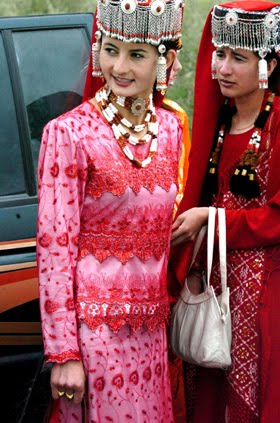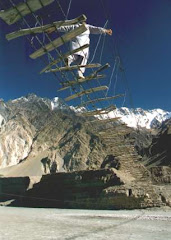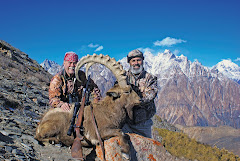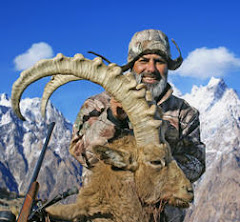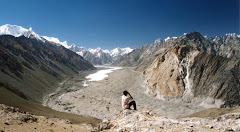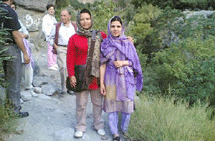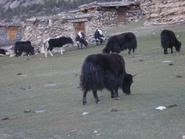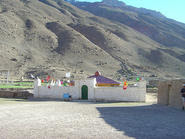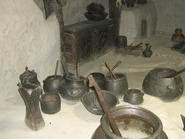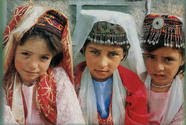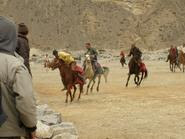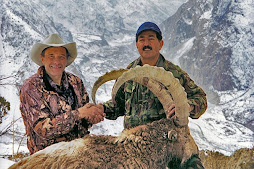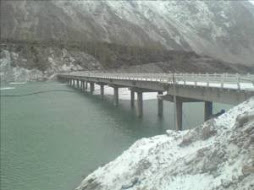Hunza Valley
The Hunza Valley (Urdu: ہنزہ) is a mountainous valley in Gilgit in the Gilgit-Baltistan autonomous region, an area under the control of the government of Pakistan. The Hunza valley is situated to the north of the Hunza River, at an elevation of around 2,500 metres (8,200 ft). The territory of Hunza is about 7,900 square kilometres (3,100 sq mi). Karimabad (formerly called Baltit) is the main town, which is also a very popular tourist destination because of the spectacular scenery of the surrounding mountains like Ultar Sar, Rakaposhi, Bojahagur Duanasir II, Ghenta Peak, Hunza Peak, Diran Peak and Bublimating (Ladyfinger Peak), all 6,000 metres (19,685 ft) or higher.
Main article: State of Hunza
Hunza was formerly a princely state bordering China to the north-east and Pamir to its north-west, which continued to survive until 1974, when it was finally dissolved by Zulfikar Ali Bhutto. The state bordered the Gilgit Agency to the south, the former princely state of Nagar to the east. The state capital was the town of Baltit (also known as Karimabad) and its old settlement is Ganish Village.
Hunza was an independent principality for more than 900 years. The British gained control of Hunza and the neighbouring valley of Nagar between 1889 and 1892 followed by a military engagement of severe intensity. The then Thom (Prince) Mir Safdar Ali Khan of Hunza fled toKashghar in China and sought what can be called political asylum.
First Muslim Thum
| “ | The ruling family of Hunza is called Ayeshe (heavenly), from the following circumstance. The two states of Hunza andNagar were formerly one, ruled by a branch of the Shahreis, the ruling family of Gilgit, whose seat of government was Nager. Tradition relates that Mayroo Khan, apparently the first Muslim Thum of Nagar some 200 years after the introduction of the religion of Islam to Gilgit, married a daughter of Trakhan of Gilgit, who bore him twin sons named Moghlot and Girkis. From the former the present ruling family of Nager is descended. The twins are said to have shown hostility to one another from birth. Their father seeing this and unable to settle the question of succession, divided his state between them, giving to Girkis the north, and to Moghlot the south, bank of the river. [1] | ” |
Thum
The traditional name for the ruler in Hunza was Thum, which is also a respectful appellation used by people of both Hunza and Nager who belong to the clan of Boorish. The Shin use the term Yeshkun for the Boorish.
| “ | Both Thums are still addressed as Soori, as a title of respect. This appears to be the same [in meaning] as Sri, an commonly prefixed to the names of Hindu princes in India, to denote their honour and prosperity. The Thum's wives are styled ghenish which is almost identical with the original Sanskrit word for mother, and their sons are called gushpoor.[2] | ” |
Geography
The Hunza is situated at an elevation of about 2,500 metres (8,200 ft). For many centuries, Hunza has provided the quickest access to Swat and Gandhara for a person travelling on foot. The route was impassable to baggage animals; only human porters could get through, and then only with permission from the locals.
Hunza was easily defended as the paths were often less than 0.5 metres (20 in) wide. The high mountain paths often crossed bare cliff faces on logs wedged into cracks in the cliff, with stones balanced on top. They were also constantly exposed to regular damage from weather and falling rocks. These were the much feared "hanging passageways" of the early Chinese histories that terrified all, including several famous Chinese Buddhist monks such as Xuanzang.
Climate
The temperature in May is a maximum of 27 °C (81 °F) and a minimum of 14 °C (57 °F); the October maximum is 10 °C (50 °F) and the minimum −10 °C (14.0 °F). Hunza's tourist season is generally from May to October, because in winter the Karakoram Highway is often blocked by the snow.
Transport
Today, the famous Karakoram Highway crosses Hunza, connecting Pakistan to China via the Khunjerab Pass. Travelling up the valley from the south, Hunza is the land to the left, and the former state of Nagar to the right of the Hunza River. Regular bus and van services operate between Gilgit and Central Hunza (Ganish Village, Aliabad and Karimabad) and also between Gilgit and Sost Gojal. PTDC Office at Gilgit, Sost and Islamabad arranges tours and transport for visitors.
Spectacular scenery
Hunza is one of the most impressive places in the world. Several high peaks rise above 6,000 metres (20,000 ft) in the surroundings of Hunza valley. The valley provides spectacular views of some of the most beautiful and magnificent mountains of the world which include Rakaposhi 7,788 metres (25,551 ft), Ultar Sar 7,388 metres (24,239 ft), Bojahagur Duanasir II7,329 metres (24,045 ft), Ghenta Sar 7,090 metres (23,261 ft), Hunza Peak 6,270 metres (20,571 ft),Darmyani Peak 6,090 metres (19,980 ft), and Bublimating (Ladyfinger Peak) 6,000 metres (19,685 ft). Hunza Valley is also host to the ancient watch towers in Ganish , Baltit Fort and Altit Fort. Watch towers are located in heart of Ganish Village, Baltit Fort stands on top of Karimabad whereas Altit Fortlies at the bottom of the valley.
The valley is popularly believed to be the inspiration for the mythical valley of Shangri-la in James Hilton's 1933 novel Lost Horizon. As one travels up on the Karakoram Highway, the beautiful sceneries keep on revealing themselves. On the way one can witness the 65 kilometres (40 mi) long 'Batura' glacier, the second longest in Pakistan, surround by Shishper, Batura and Kumpirdior peaks. On reaching Sost one can continue the journey up to Khunzhrav or turn west to witness the mystic beauty of Chipursan (also Chapursan) valley. Chipursan valley has some of most exotic tourist spots in the area. In Yarzerech (also Yarzirich) you can have a look at the majestic Kundahill peak (6,000 metres (19,685 ft)), or trek along the Rishepzhurav to the Kundahill to experience the soothing sceneries. Beyond Yarzerech one can travel further to Lupghar, Raminj, Reshit, Yishkuk up to Bobo Ghundi (Oston), the shrine of Baba-e-Ghund, a saint from Afghanistan near the border between Pakistan and Wakhan region of Afghanistan.
People of Hunza
As much as the valley is famous for its beauty, the people of Hunza are noted for their friendliness and hospitality. The local languages spoken are Burushaski, Wakhi and Shina, many people understandUrdu. The literacy rate of the Hunza valley is believed to be more than 90%. Virtually every child of the new generation studies up to at least high school level. Many pursue higher studies from prestigious colleges and Universities of Pakistan and abroad.
Most of the people of Hunza are Ismaili Shia Muslims, followers of His Highness Prince Karim Aga Khan IV, while in Ganish Village more than 90% are Shia Muslims.
The Hunza region is home to people of three ethnicities:
- The Lower Hunza area - (from Khizerabad to Nasirabad is mainly inhabited by the Shinaki people who are Shina speakers;
- The Central Hunza area - (from Murtazaabad to Ahmedabad) is mainly inhabited by Burushaski speakers.
- The Upper Hunza area, known as Gojal - (from Shiskat to Khunjerab is mainly populated by Wakhi speakers;
The majority of the people are Ismaili Shia Muslims who are followers of the Aga Khan. The present Aga Khan IV has provided a lot of funding for the area to help with agriculture and the local economy through the Aga Khan Development Network.
New District
Hunza-Nagar became a new district in Gilgit-Baltistan starting in July, 2009. There is planned to be a Northern Areas Legislative CouncilAssembly (NALA) seat for Hunza.[3]
See also
- Former State of Hunza
- Baltit Fort
- Altit Fort
- Northern Areas
- Karakoram Highway
- Karakoram Mountains
- Nagar Valley
- Burusho
- Ganish Village
- Karimabad
- Khizerabad
- Nasirabad
- Ahmedabad
- Hussainabad
- Murtazaabad
- Sikandarabad
- Jafarabad
- Hunza-Nagar District
The Hunza valley contains many small villages. The first village is Khizerabad. Prior to the early 20th century, the people of the Hunza valley are said to have had an average lifespan of 100.[citation needed] This group of people were highly associated with nature, especially regarding dieting habits and lifestyle. They highly acknowledged the apricot seed, using it as currency. The women would squeeze out the liquid of the seeds, and spread it over their foreheads, eliminating their wrinkles even at an extraordinary age. Unfortunately with more contact to the outside world, the Hunzus' average lifespan increasingly dropped, due to different ideas and lifestyle their group was obtaining from other peoples. The Hunzu valley is frequently referred to as Shangri La, and is also known as "The Valley Where you Live Forever"
References
- Kreutzmann, Hermann, Karakoram in Transition: Culture, Development , and Ecology in the Hunza Valley, Oxford University Press, 2006. ISBN 9780195472103
- Leitner, G. W. (1893): Dardistan in 1866, 1886 and 1893: Being An Account of the History, Religions, Customs, Legends, Fables and Songs of Gilgit, Chilas, Kandia (Gabrial) Yasin, Chitral, Hunza, Nagyr and other parts of the Hindukush, as also a supplement to the second edition of The Hunza and Nagyr Handbook. And An Epitome of Part III of the author’s “The Languages and Races of Dardistan.”First Reprint 1978. Manjusri Publishing House, New Delhi.
- Lorimer, Lt. Col. D.L.R. Folk Tales of Hunza. 1st edition 1935, Oslo. Three volumes. Vol. II, republished by the Institute of Folk Heritage, Islamabad. 1981.
- Sidkey, M. H. "Shamans and Mountain Spirits in Hunza." Asian Foklore Studies, Vol. 53, No. 1 (1994), pp. 67–96.
- History of Ancient Era Hunza State By Haji Qudratullah Beg English Translation By Lt Col (Rtd) Saadullah Beg, TI(M)
External links
- Hunza Holidays Plus Trekking & Tours Pakistan
- Explore Pakistan Tourism
- A local blogger from Baltit in Hunza
- Kundahill peak
